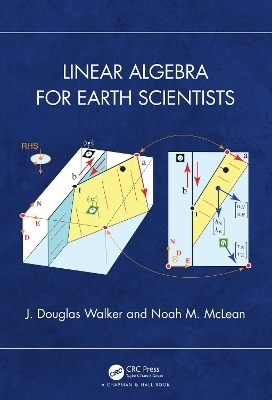
Linear Algebra for Earth Scientists
Chapman & Hall/CRC (Verlag)
978-1-032-55594-2 (ISBN)
Linear Algebra for Earth Scientists is written for undergraduate and graduate students in Earth and Environmental sciences. It is intended to give students enough background in linear algebra to work with systems of equations and data in geology, hydrology, geophysics, or whatever part of the Earth Sciences they engage with.
The book does not presuppose any extensive prior knowledge of linear algebra. Instead, the book builds students up from a low base to a working understanding of the sub t that they can apply to their work, using many familiar examples in the geosciences.
Features
Suitable for students of Earth and Environmental Sciences
Minimal prerequisites — written in a way that is accessible and engaging for those without a mathematical background
All material presented with examples and applications to the Earth Sciences
J. Douglas Walker works on the integration of Tectonics, Geochronology, and Geoinformatics to better understand the geologic development of plate boundaries. His work has addressed problems in the development of contractile belts in a backarc setting, the response of the lithosphere to extensional deformation, and past and active strike-slip faulting. This work relies on the quantification of Earth Science problems and the assessment of uncertainty in geology. Walker’s active research program spans the gamut from developing software/hardware combinations for geologic mapping in the field to regional database development for solving tectonic problems. Walker received his B.S., M.S., and Ph.D. from the Massachusetts Institute of Technology. Since defending his dissertation work in 1985, he has been at the University of Kansas teaching courses in structural geology, tectonics, field geology, historical geology, error analysis, and linear algebra. He is currently the Union Pacific Resources Distinguished Professor in Geology. He has a long service record with the Geological Society of America and is a former President of this organization. He also received the Outstanding Contributions in Geoinformatics Award from the Geological Society of America (2019) and the Distinguished Service Award from the Geochemical Society (2013). Noah M. McLean works on problems in geochronology, thermochronology, and isotope geochemistry. One direction of his research involves understanding how ages are measured, and making measured ages more accurate and precise. This line of questions has led him to collaborations with geochemists and geophysicists. With computer scientists he has helped to build community tools for interpreting those measurements. Other lines of research involve applying geochronology techniques to understanding geological problems like large-volume silicic magma system behavior, geochronology of the terrestrial sedimentary record, and timescales of mountain-building processes. McLean received his B.S. from the University of North Carolina at Chapel Hill and his Ph.D. from the Massachusetts Institute of Technology. After a postdoctoral position at the British Geologic Survey, he joined the Geology Department at the University of Kansas, where he is currently the Hubert H. and Kathleen M. Hall Associate Professor.
1. Rows and Columns. 1.1. The Three-Point Problem. 1.2. Can we solve this more easily using Linear Algebra? 1.3. Thinking about Columns and Vectors. 1.4. Vectors. 1.5. A Geochemical Example. 1.6. Summary. 1.7. Exercises. 2. Matrix multiplication. 2.1. Multiplying the Linear Algebra Way. 2.2. Transpose of a Vector or Matrix. 2.3. Linear Combinations. 2.4. Linear Transformations. 2.5. Geologic Transformations. 2.6. What more can we do with Matrices? 2.7. More about 3D Rotations. 2.8. Summary. 2.9. Exercises. 3. Solving Ax = b. 3.1. Elimination. 3.2. Elimination Matrices and Elementary Row Operations. 3.3. Elementary Matrices and their Inverses. 3.4. Our First Factorizations — A = LU = LDU. 3.5. Gauss-Jordan Elimination and Computing A-1. 3.6. The Three-Point Problem Many Ways. 3.7. Reworking the Geochemical Example. 3.8. Summary. 3.9. Exercises. 4 When does Ax = b have a solution? 4.1. Slip with Different Number of Faults. 4.2. The Three-Point Problem with more Points. 4.3. The Vector b must be in the Column space of A to find x. 4.4. Exploring the vector spaces and Subspaces of Ax=b. 4.5. Rank and Size of a determines if we can solve Ax = b. 4.6. Summary. 4.7. Exercises. 5. Solving Ax = b when there is no solution. 5.1. Projection. 5.2. Solving Projection for Lines and Planes. 5.3. Can we fit something other than a Line or Plane. 5.4. Summary. 5.5. Exercises. 6. Determinants and Orthogonality. 6.1. Determinants, Strain, and Geologic Transformations. 6.2. Strain, Determinants, and Basic Matrix Operations. 6.3. Cross Products. 6.4. Orthogonality and Gram-Schmidt Process. 6.5. Decomposition – Our next Factorization. 6.6. Summary. 6.7. Exercise. 7. An Earth Scientist’s view of the characteristics of Eigenvalues and Eigenvectors. 7.1. Motivation for Eigenanalysis. 7.2. Eigenvalues and Eigenvectors. 7.3. Looking at Data and not Ax=b. 7.4. Diagonalization into Xλx-1. 7.5. A. Detailed look at what XT, Λ, and X Do. 7.6. Summary. 7.7. Exercises. 8. Change of Basis, Eigenbasis, and Quadratic Forms. 8.1. Change of Basis. 8.2. What do these results mean for the Eigenbasis? 8.3. The Geologist’s Dilemma - Setting a Bruntonr Compass. 8.4. A Nice Gneiss. 8.5. Stressing the use of Eigenanalysis. 8.6. Quadratic Forms. 8.7. Summary. 8.8. Exercises. 9. Singular Value Decomposition. 9.1. What is Singular Value Decomposition or SVD? 9.2. SVD for any Matrix. 9.3. When do Simple and Pure Shear produce the same strain Ellipse? 9.4. Using SVD to solve Ax = b. 9.5. Condition Numbers, or, when good Matrices go bad. 9.6. Summary. 9.7. Exercises.
| Erscheinungsdatum | 19.04.2024 |
|---|---|
| Zusatzinfo | 115 Line drawings, color; 115 Illustrations, color |
| Sprache | englisch |
| Maße | 178 x 254 mm |
| Gewicht | 780 g |
| Themenwelt | Mathematik / Informatik ► Mathematik ► Algebra |
| Mathematik / Informatik ► Mathematik ► Angewandte Mathematik | |
| Naturwissenschaften ► Geowissenschaften ► Geologie | |
| ISBN-10 | 1-032-55594-7 / 1032555947 |
| ISBN-13 | 978-1-032-55594-2 / 9781032555942 |
| Zustand | Neuware |
| Informationen gemäß Produktsicherheitsverordnung (GPSR) | |
| Haben Sie eine Frage zum Produkt? |
aus dem Bereich


